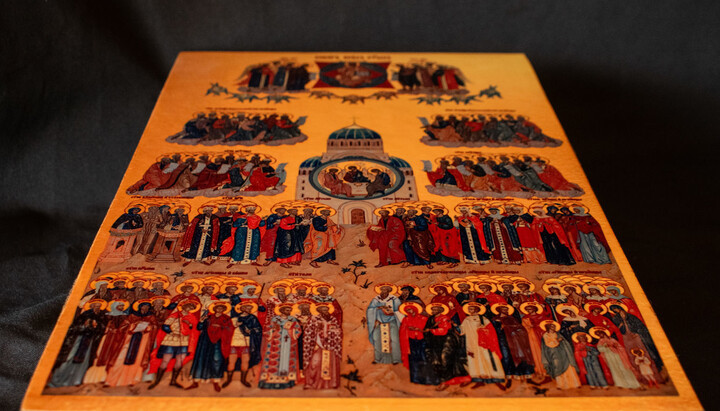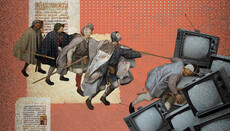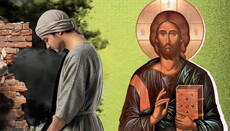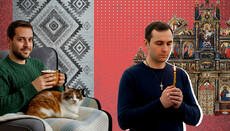The main algorithm of the path to holiness

Death, the “last enemy,” is now revealed as the triumph of Divine love – as an entrance into the Kingdom of Life.
Following the Feast of Pentecost, when the Holy Spirit descended upon the apostles, we commemorate All Saints – that is, those who embodied the action of the Holy Spirit, who became for us examples to emulate, models of God-likeness.
Each of them lived a unique, unrepeatable life, realizing the particular potential for holiness granted to them by God alone. But let us ask: is there a common denominator uniting all saints without exception? To answer this, we must turn to Christology – for the incarnate Son of God is the perfect model of what man was meant to be in God’s design.
According to Scripture, the first humans, by violating God’s commandment, chose an autonomous way of existence. They believed that their own natural energies would suffice for eternal life in the created world. But the devil’s temptation turned out to be a treacherous lie – sin entered the world, and with it, death. From that moment on, the life path of every person born on earth ends in death: the life force fades, and the body, formed from the earth, returns to the earth.
But God not only formed man from dust – He breathed into him His breath, thereby imparting His likeness. This is the immortal personhood, or hypostasis, which transcends our created nature. Because of it, prior to the Fall, humanity could live not only as other creatures do, but had the potential to realize a divine mode of existence. This would require transcending dependence on created nature, gradually clothing oneself in the uncreated Divine energies. Thus the life of all humanity could have become a likeness of the life of the Holy Trinity. Possessing a common nature, people would attain unity in God through mutual love and harmony. Eternal life would have resulted from theosis – participation in the life-giving energy of the Holy Trinity. But tragically, humanity chose another path – and could not correct this choice on its own.
The New Adam – God Himself become Man – rectified it. He crossed the boundaries of His own divine nature. Not subject to any essential or natural necessity, God was able to hypostasize not only His own divine being, but also human nature in His Person. The kenosis (self-emptying) of the Divine Logos consists in His descent to our lower nature, which He had not previously possessed. The Creator began to exist in the form of His own creation. The timeless entered time, the infinite became finite, the eternal took on the form of an Infant, the incorporeal assumed a body. Being true God, the Second Person of the Trinity became true Man.
The first man rejected the possibility of realizing his being in the image of the Trinity. Instead of self-denial for love of God and His creation, he directed the energy of his will toward death. Christ, the New Adam, did the exact opposite: He freely subordinated His human will to the Divine will – to the will of True Life, manifest in obedience to His Heavenly Father and in self-giving love.
This is the essential direction our human will must follow.
The core problem for many people is that we constantly resist God’s will, which leads us to salvation. We do not want to accept the destiny given to us by God – or, in other words, to carry our cross.
We lack the humility of the Savior, the obedience to God’s will. We want our lives to unfold according to our desires, as we see and understand them. Many of our prayers express exactly this: we ask God to alter His will and to act as we request. Our desires are predictable – we want a peaceful, quiet, cloudless life, with all we need for happiness, joy, and comfort. These are gifts of God – but gifts meant for the Kingdom of Heaven. Here on earth, we are merely sojourners. Here, we labor for that very happiness every reasonable person longs for. Here is the cross and the struggle for the salvation of our soul.
Naturally, the cross brings no pleasant sensations. Christ did not rejoice at what He would endure for humanity’s salvation. In Gethsemane, His soul was anguished and sorrowful. Sweat like drops of blood fell from His brow – capillaries burst from intense inner stress. He prayed to His Heavenly Father that the cup of suffering might pass. Yet, knowing the horror He must undergo, Christ subjected His human will to the Divine and freely accepted the cup of sorrow and suffering. “Thy will be done,” He said – as Man, on behalf of all humanity. And He offered Himself as a Sacrifice for the whole world.
This is our example of the narrow, thorny, and only path that leads to the Kingdom of God. This is the path of all the saints. Unlike many of us, they did not merely endure what was appointed to them – they often increased the burden of their cross out of love for God. And they did so joyfully, without fear or despondency.
The principal consequence of the Fall was death. Throughout human history – until Christ’s coming – it sounded as the final, hellish chord, the apex of destruction wrought by sin within human nature. The death of each individual is the unavoidable price for existential autonomy – for a life cut off from Divine energies. But it was Christ’s death that became the decisive act of victory over our death:
“For as by man came death, by man came also the resurrection of the dead. For as in Adam all die, even so in Christ shall all be made alive” (1 Cor. 15:21–22).
What does Christ’s Resurrection mean for each individual? It means that through obedience to the Father “even unto death,” Christ brought human nature to complete renunciation of all claims to existential self-sufficiency. He transformed natural life into communion with Divine love and into freely chosen obedience to the Divine will. After Christ’s Resurrection, our nature – its being now grounded in union with God – no longer dies. Though still created, it has been granted the ability to live according to the mode of the uncreated. Christ’s resurrected Body – our future body as well – is material and created by nature, but exists in the mode of the uncreated: no longer subject to the necessities of nature.
What practical conclusions follow from this? The only path to salvation is co-dying, or co-crucifixion, with Christ. This is the meaning of the Savior’s words:
“If anyone would come after Me, let him deny himself, take up his cross daily, and follow Me. For whoever would save his life will lose it, but whoever loses his life for My sake will save it” (Luke 9:23–24).
Thanks to Christ’s Death and Resurrection, Divine love receives the death of each person just as it received the Sacrifice of the Son of God – as a rejection of resistance to Divinity, and as an assent to be reunited with God. In the Person of the Risen and Ascended Son, God the Father embraces all human flesh that renounces its claim to independent existence. Thus God unites with every person and grants them life. Death, the “last enemy” (1 Cor. 15:26), is now revealed as the triumph of Divine love, as the entrance into the Kingdom of Life. That is why St. Paul writes to the Corinthians:
“For we know that if the earthly tent we live in is destroyed, we have a building from God, a house not made with hands, eternal in the heavens... while we are at home in the body, we are away from the Lord... we would rather be away from the body and at home with the Lord” (2 Cor. 5:1, 6, 8).
But even before biological death, every voluntary renunciation of personal autonomy and independence from God is a repetition and imitation of the Crucified Son of God. This is the path of holiness. The flesh in which we live continues to draw life from biological functions. But through the union in Christ of Divine and human nature, we have been granted participation in the life of the Holy Trinity.
In the Person of the Savior, our human nature enters into a relationship with God that mirrors the relationship between the Divine Father and the Divine Son. The Father’s love for the Incarnate Son is not a subjective emotion – it is a life-giving energy, the source of all being. Thus, our human person is joined to the stream of life that flows through our nature by virtue of its hypostatic union with Divinity in the Person of Christ. This occurs when our individual flesh, either by necessity (through death) or voluntarily (through asceticism or martyrdom), renounces its stubborn drive for autonomy and self-sufficiency.
Just as Divine love once created the world through the Word, so now, through that same Word – now incarnate – this same love renews all creation, rendering it incorruptible, eternal, and immortal.











